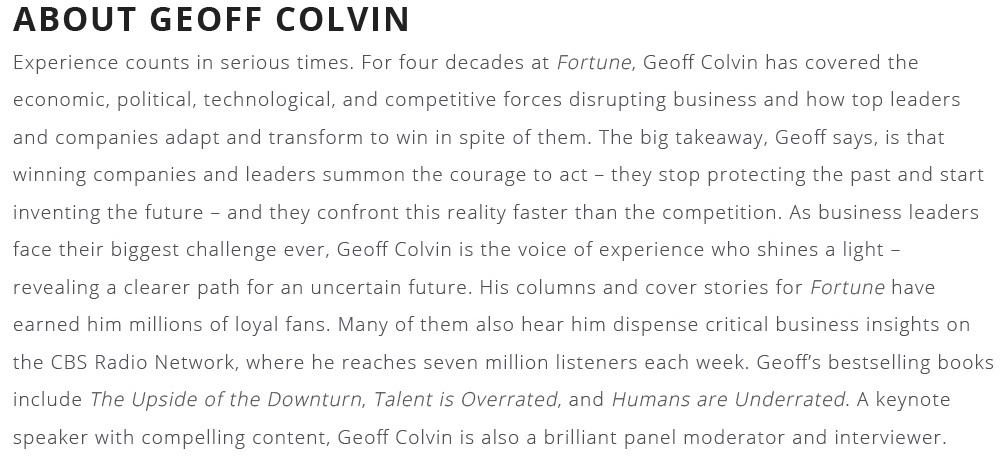Organizational Transformation: IBM Cuts Teleworking to Boost Effective Collaboration in the Workplace
THE FUTURE OF WORK AT IBM
When I read the news about IBM's decision to have most teleworkers return to their offices I knew it was something Fortune magazine's GEOFF COLVIN would be following closely. His last book, Humans are Underrated, focused on where humans fit in and add value in a workplace culture that is increasingly dominated by robots and smart technology of every sort. What did IBM's move mean for the future of work? Will this organizational transformation really increase effective collaboration in the workplace as IBM hopes?
Geoff's concise essay on IBM's decision is below. He will be following it closely and will weigh in down the road with the impact this change makes for the company and the ramifications more broadly in the workplace. What do YOU think? Feel free to comment at the end of this article.
IS IBM'S NEW TELEWORKING POLICY A BIG GAMBLE? by GEOFF COLVIN
IBM sparked intense debate last week when it ordered remote workers to move into IBM offices, and debate is warranted. Yet one fact is already powerfully clear: Bringing people physically together makes them more collaborative, innovative, and creative. I won’t try to predict the ultimate result of IBM’s move; too many other factors will influence that. But every company wants all the advantages it can get, and IBM is giving itself a big advantage.
Magic happens when people interact in person, face-to-face. Research shows that our brains literally synchronize; the same parts of our brains light up at the same time when we’re talking together, looking at one another. If we have the same conversation back-to-back, the synchronization disappears. The pupils of our eyes dilate and constrict in sympathy with one another when we talk face-to-face, and though we aren’t even aware of it happening, it builds trust between us. We unconsciously mimic each other’s posture and tone of voice, and this also builds trust.
That’s critically important because creativity can’t happen without trust, as I explain in my book Humans Are Underrated: What High Achievers Know That Brilliant Machines Never Will. A team of researchers from two U.S. universities and three European universities recorded interactions within several different teams, and also asked independent raters to gauge the creativity and quality of the teams’ ideas. The teams were highly educated people working on projects involving computer science, economics, psychology, and other fields. Results: The more that group members faced each other, the more creative was their output. The more they looked into each other’s eyes, the more creative they were. The more willing they were to confide in one another, the more creative they were.
Those behaviors might not have immediately signaled creativity to you, but they may well have suggested something else: trust. Facing each other, looking into the eyes, confiding – all those behaviors reflect and build trust. As it happened, the researchers measured trust within the groups and found that it was crucial to the whole process; more trust led to more creative and higher quality ideas. Their conclusion: “There is no substitute for face-to-face interaction to build up this trust.”
SUPPLEMENTAL RESOURCES:
Geoff Colvin: Humans Are Underrated Speech Description,
Smart Technology & Robots at Work: The Workplace of the Future
and Top Organizational Change Speakers on Successful Change Management
Now consider this question: Why do Google’s employee cafeterias serve gourmet-quality food for free? It isn’t to attract the best workers; plenty of them already want to work at Google. It’s to make sure everyone will come to the cafeteria at mealtimes. Google makes sure they’ll have to stand in line, where they can talk to each other, and it puts the tables too close together so people will literally run into each other – and talk. It’s all deliberate. The objective is to spark innovation. John Sullivan of San Francisco State University, who has studied Google and innovation generally, concludes, “If you want innovation, then you need interaction.”
Which brings us back to IBM. People who work from home are often more productive than office workers, but they’re less innovative, research finds. Companies that need maximum innovation, creativity, and effective collaboration in the workplace – and what company doesn’t? – are realizing they have much to gain by engaging the magic that happens only with physical presence.
About Tony D'Amelio
Tony has spent his career putting talented people and audiences together, first in the music business and later representing the world's leading speakers. After concluding 27 years as Executive Vice President of the Washington Speakers Bureau, Tony launched D'Amelio Network, a boutique firm that manages the speaking activities of a select group of experts on business, management, politics and current events. Clients include: Mike Abrashoff, Mariana Atencio, Chris Barton, Lisa Bodell, Geoff Colvin, Daryl Davis, Suneel Gupta, Ron Insana, Katty Kay, Polly LaBarre, Nicole Malachowski, Ken Schmidt, and Bob Woodward.

.png)

.jpg)


